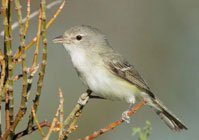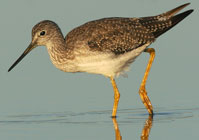Accomplishments
The CVJV partnership has earned an impressive record of accomplishment since its inception in 1988, and is making great progress towards meeting the objectives identified in its 2020 Implementation Plan.

 Bell’s Vireo
Bell’s Vireo
On May 31st, Secretary of the Interior Ken Salazar signed the 2012 Revision of the North American Waterfowl Management Plan, reaffirming the Department’s commitment to one of the largest and most successful continent-wide conservation initiatives ever undertaken.
“The 2012 Revision of the North American Waterfowl Management Plan provides a renewed and energized vision for the future of waterfowl and wetlands conservation,” Salazar said. “The blueprint lays out an adaptable waterfowl management strategy that leverages international resources to ensure abundant waterfowl populations and preserves habitat to support hunting and other recreational uses.”
“The importance of waterfowl, in both ecological and economic terms, has placed waterfowl managers at the forefront of the conservation profession,” said U.S. Fish and Wildlife Service Director Dan Ashe. “This Revision acknowledges and embraces a 21st century approach to landscape-level conservation that is truly community-driven.”
First signed in 1986 by the United States and Canada, with Mexico becoming a signatory in 1994, the North American Waterfowl Management Plan (NAWMP) is an international strategy for conserving migratory waterfowl throughout the continent. It has remained a leading model for other international conservation plans.
NAWMP is implemented largely by public-private partnerships known as Migratory Bird Joint Ventures. As of 2011, the Joint Ventures in the U.S. and Canada had collectively conserved more than 15.7 million acres of habitat. Over the course of their history, 18 U.S. Joint Venture partnerships have leveraged every dollar of allocated Congressional funds into an average of $35 in matching funds.
2012 marks the 25th anniversary of Joint Ventures. California has the unique distinction of hosting five Joint Ventures: the Central Valley Joint Venture (CVJV), Intermountain West Joint Venture (IWJV), Pacific Coast Joint Venture (PCJV), San Francisco Bay Joint Venture (SFBJV) and Sonoran Joint Venture (SJV). All have developed diverse partnerships to help protect, manage, enhance, and restore migratory bird habitat throughout the west.
All can claim significant accomplishments:
The voluntary partnerships fostered by these, and other habitat Joint Ventures, have served as innovative models for cooperative and effective landscape conservation, with far-reaching benefits to birds and other wildlife populations.
The signing of the 2012 NAWMP Revision highlights the commitment of Mexico, Canada and the United States to developing common objectives that reflect the interrelated nature of waterfowl management and aligning and coordinating efforts to reach those objectives.
The CVJV partnership has earned an impressive record of accomplishment since its inception in 1988, and is making great progress towards meeting the objectives identified in its 2020 Implementation Plan.

Follow these links to learn about some of the important bird conservation work happening in California's Central Valley.
